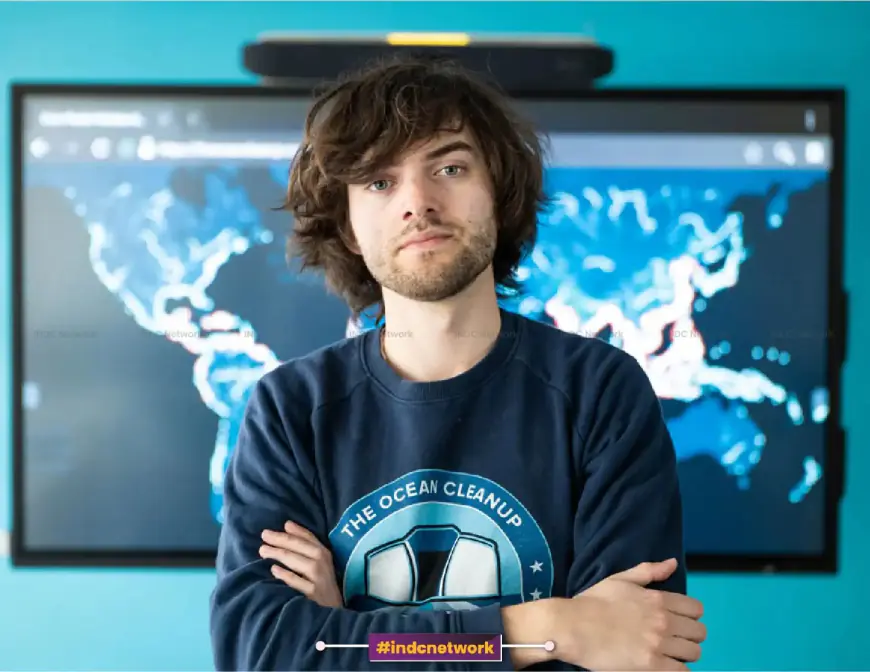Boyan Slat and The Ocean Cleanup: A Bold Vision to Eradicate Ocean Plastic Pollution
Boyan Slat, the founder of The Ocean Cleanup, has become a leading figure in the fight against ocean plastic pollution. His innovative approach aims to remove plastic waste from the world’s oceans, with a focus on cleaning the Great Pacific Garbage Patch. This article explores Boyan Slat’s journey, the challenges faced by The Ocean Cleanup project, and the significant strides made towards achieving a cleaner, healthier ocean.

INDC Network : Biography : Introduction: The Man Behind the Vision – Boyan Slat
In 2011, a 16-year-old Dutch student named Boyan Slat made an extraordinary observation that would shape his future and the future of environmental conservation. While diving in Greece, Slat noticed a disturbing amount of plastic waste floating in the water. This realization led him to question why the ocean, one of the Earth’s most vital ecosystems, was so heavily polluted with plastic debris.
This simple yet profound question set Slat on a mission to tackle one of the planet’s most pressing environmental crises—ocean plastic pollution. At the time, the scale of the problem seemed overwhelming, but Slat was undeterred. By 2013, at just 18 years old, he founded The Ocean Cleanup, a non-profit organization dedicated to developing innovative technologies to remove plastic waste from the world’s oceans.
Since then, Boyan Slat has become a symbol of hope in the battle against ocean plastic, garnering global attention for his ambitious vision and his groundbreaking technology. Through The Ocean Cleanup, Slat has attracted support from scientists, engineers, environmentalists, and the general public, all united in their desire to rid the oceans of plastic waste.
The Ocean Cleanup: The Vision and the Solution
The core mission of The Ocean Cleanup is to remove plastic waste from the world’s oceans, starting with the Great Pacific Garbage Patch (GPGP), which is the largest accumulation of ocean plastic. The GPGP spans an area of more than 1.6 million square kilometers (twice the size of Texas) and contains an estimated 80,000 tons of plastic.
Boyan Slat’s vision for The Ocean Cleanup is to reduce the amount of plastic in the ocean by 90% by 2040. This ambitious target requires innovative technologies, a strategic approach, and the collaboration of governments, organizations, and individuals. The Ocean Cleanup’s ultimate goal is to create a sustainable, large-scale system capable of cleaning up the world’s oceans and preventing further plastic waste from entering marine environments.
The Technology Behind The Ocean Cleanup
The Ocean Cleanup’s technology is based on a system that uses the natural forces of the ocean to passively collect plastic debris. The concept is a floating barrier system that would be deployed in areas with high concentrations of plastic, such as the Great Pacific Garbage Patch.
Key Components of the Cleanup System:
-
Floating Barrier: The system is designed around a large, U-shaped barrier made of durable, lightweight materials. The barrier is designed to drift with the currents, catching plastic waste as it moves through the ocean. The barrier’s design allows it to work with the ocean’s natural flow, which helps capture plastic while causing minimal disruption to marine life.
-
Collection Platform: The floating barrier is connected to a central collection platform where plastic debris is stored. The platform collects plastic debris as it is swept into the system, and it can be periodically emptied and transported back to shore for recycling or disposal.
-
System Scalability: The Ocean Cleanup has designed the system to be scalable, meaning that it can be deployed in multiple locations and adapted to different ocean environments. As the project grows, the number of barriers and collection platforms will increase, leading to a significant reduction in ocean plastic over time.
-
Autonomous Vessels: The Ocean Cleanup is also developing autonomous vessels that can assist in collecting plastic debris from the ocean. These vessels work in tandem with the barrier systems to capture and transport plastic waste more efficiently.
The Journey: From Concept to Reality
Boyan Slat’s idea for The Ocean Cleanup started as a simple concept, but transforming this idea into a working, scalable system was no easy task. The road to success was filled with technical, logistical, and financial challenges.
Initial Development and Testing
The first step in The Ocean Cleanup’s journey was to develop a prototype of the plastic-collecting system. In 2014, the team launched its first prototype, known as System 001, for testing in the Pacific Ocean. However, the system encountered several issues, including structural problems that caused it to break apart during testing.
Despite these setbacks, Boyan Slat and his team remained determined to improve the technology. After further testing, refinements, and adjustments, System 001/B was launched in 2018. This system demonstrated better stability and was able to successfully collect plastic from the ocean.
Progress and Achievements
Since the successful deployment of System 001/B, The Ocean Cleanup has made significant strides in its mission. Some of the key milestones include:
-
First Successful Plastic Collection (2019): In 2019, The Ocean Cleanup successfully collected plastic debris from the Great Pacific Garbage Patch for the first time. This marked a significant breakthrough, proving that the technology could effectively capture and remove plastic from the ocean.
-
Scaling Up Operations (2020): In 2020, The Ocean Cleanup announced plans to scale up its operations by deploying larger systems capable of collecting more plastic waste. The organization also began testing new collection systems in other parts of the ocean, including the Great Atlantic Garbage Patch.
-
Partnerships and Collaborations: The Ocean Cleanup has forged partnerships with major organizations, such as BMW Group, Google, and the Dutch government, to fund its efforts and bring attention to the issue of ocean plastic pollution. These collaborations have played a crucial role in helping the project grow and expand its impact.
-
Recycling and Waste Management: As The Ocean Cleanup continues to collect plastic, it has started focusing on recycling the material. The goal is to turn the plastic waste collected from the ocean into valuable products, such as clothing, shoes, and even recycled plastic for new products. This step not only helps reduce plastic pollution but also adds a layer of sustainability to the project.
Challenges and Criticisms
While The Ocean Cleanup’s progress has been impressive, the project has faced its share of challenges and criticisms:
-
Effectiveness in Removing Plastic: Some critics argue that The Ocean Cleanup’s system may not be as effective as anticipated in removing plastic from the ocean. Critics point out that the plastic collected may not make a significant dent in the overall amount of ocean plastic, and they suggest that a more holistic approach, such as reducing plastic production, may be necessary.
-
Environmental Impact: Another concern raised is the potential impact of the cleanup systems on marine life. While The Ocean Cleanup’s technology is designed to avoid harming marine organisms, critics question whether the large-scale deployment of such systems could inadvertently cause disruption to ecosystems.
-
Cost and Funding: As with any ambitious project, funding is a major challenge. While Boyan Slat has received support from donors, investors, and governments, the project’s cost is high, and there are ongoing concerns about how sustainable the project’s funding model is in the long term.
The Future of The Ocean Cleanup
Despite the challenges, Boyan Slat’s vision remains unwavering. The Ocean Cleanup continues to develop new technologies and refine existing systems, with the aim of achieving its goal of reducing ocean plastic by 90% by 2040.
The project has also expanded its scope beyond the Great Pacific Garbage Patch. In 2021, The Ocean Cleanup announced plans to tackle other ocean plastic hotspots, including the Great Atlantic Garbage Patch and river systems that contribute to ocean pollution.
In the coming years, The Ocean Cleanup will play a vital role in addressing the growing issue of ocean plastic pollution. By continuing to innovate and collaborate with global partners, Boyan Slat and his team are bringing hope to a problem that has long seemed insurmountable.
A Cleaner Ocean for Future Generations
Boyan Slat’s groundbreaking work with The Ocean Cleanup is helping to turn the tide on ocean plastic pollution. Through innovative technology, strategic partnerships, and a tireless commitment to change, Slat is leading the way toward a cleaner, healthier ocean. While the road ahead remains challenging, the success of The Ocean Cleanup proves that even the most complex environmental issues can be tackled with innovation, collaboration, and determination.
What's Your Reaction?














































































































































































